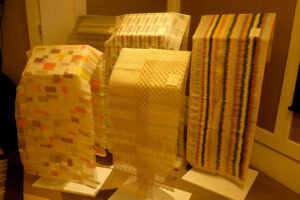By Giselle P. Kasilag
WEAVING is one of the most ancient traditions common to all civilizations. The history of the world is written in the threads and expressed in the patterns.
While the method may be old, HABI: The Philippine Textile Council is confident that weaving is where our future lies. The process may have remained largely unchanged but many innovations have been developed that are putting the spotlight back on Philippine textiles. Thus, there is much excitement for this year’s Likhang Habi Market Fair, happening at the Glorietta Activity Center from Oct. 18 to 20.
“Our theme this year is ‘Earth to Loom: Celebrating Natural Dyes in the Philippines,’” announced HABI president Mia Villanueva at a press conference. “We try to think of issues and things that affect the Philippine textile industry, and one thing we thought of recently is to put this in the forefront because, usually, what people use is chemical dyes.”
The council is encouraging the use of natural dyes which are more sustainable for the industry and better for the environment. But the risks brought about by deforestation, unbridled land development, and climate change are all infringing on the wealth of plant life used in dying threads and textiles. If unchecked, they threaten the range of colors should certain plants cease to be available to weavers.
The relationship between the weaver, the industry, and the environment could not be more direct. The challenges faced by one are also devastating to the others. Thus, for the industry to thrive, care for the weaver and planet are essential.
Now on its 14th year, the fair features weavers and artisans from all over the country, highlighting the richness and diversity of local textiles. What began in 2009 with 12 booths now boasts of 100 booths with 90 vendors — each one handpicked by the council to ensure the quality, sustainability, and the use of appropriate practices in the industry. Sixty-three are from Luzon, 11 are from the Visayas, and 16 from Mindanao.
“We really vet the people to make sure that it’s authentic,” said Ms. Villanueva. “We really meet with them. A lot of them have been our partners for years and they keep coming back. It’s like a progression. For the new ones, we go on trips. We visit them so that we’ll see their operations. We go to them to start a relationship. They are also invested in that relationship with us. So we can vouch for them.”
Among the most-awaited events of the fair are two competitions: the 7th Lourdes Montinola Piña Weaving Competition and the 3rd Eloisa Hizon-Gomez Abaca Weaving Competition. These two events encourage innovations in terms of methodology, use of materials, and creation of patterns that keep the industry fresh and moving forward. The entries will be on display at the fair.
“The stunning thing about this competition is that they would also revive old techniques of weaving and making textiles which they have stopped doing because nobody wanted it, there was no interest. But with this competition, all of these are starting to come out now so we are able to document it as well. It is very encouraging,” said Adelaida Lim, HABI president emeritus.
She added that the council has also observed a growing interest among the younger generation to continue the craft. It’s not just old ladies who are weaving, she noted. The council offered a special prize for weavers under 30 years old and were surprised with both the volume and quality of entries which now gives them confidence about the future of weaving and textiles in the country.
While the future seems bright, Ms. Villanueva said there is so much still to be done. When asked if there exists a registry of weaves which is essential in protecting the intellectual property of the weavers and their communities, as well as the integrity of the product, she admitted the council does not have one. While there is much documentation of the various communities and their indigenous weaves and patterns, she has not seen a consolidated list that the industry can use as a reference.
For their part, she told BusinessWorld that the council has begun a basic mapping of the different weaves and their origin regions. But this is a rudimentary effort and will have a long way to go before a registry is realized — a project that she hopes the government will undertake to benefit all the stakeholders. For now, the council is doing the best it can to visit and document as many weavers and weaving communities they can reach.
This also puts in focus the role of HABI and the Likhang Habi Market Fair in the development of the industry. The event is not just for shopping or fashion. It is about the preservation of a cultural heritage that has been passed on for centuries and continues to have relevance in the lives of the people.
“When we started, I didn’t know anything,” acknowledged HABI founder and chairman emeritus Maria Isabel Ongpin. “All I knew was that Philippine fabrics were unique, colorful, and varied. And they’re part of our identity as Filipinos and should be preserved. One of the first things that we did was to raise consciousness about not haggling them to the bottom. Don’t make them barat! They are weaves that you cannot do, that are done by artists, so stop this haggling! The second thing is that we learn from our weavers. The weavers also learn from us. The main thing is, let us preserve, develop, and modernize our textiles.”
Indeed, the future or the textile industry appears to be as colorful as the fabrics that they weave. And with the right education, the market is now realizing the value of every thread, every knot, and every interlacing of yarns that make up the fabric of our culture.















